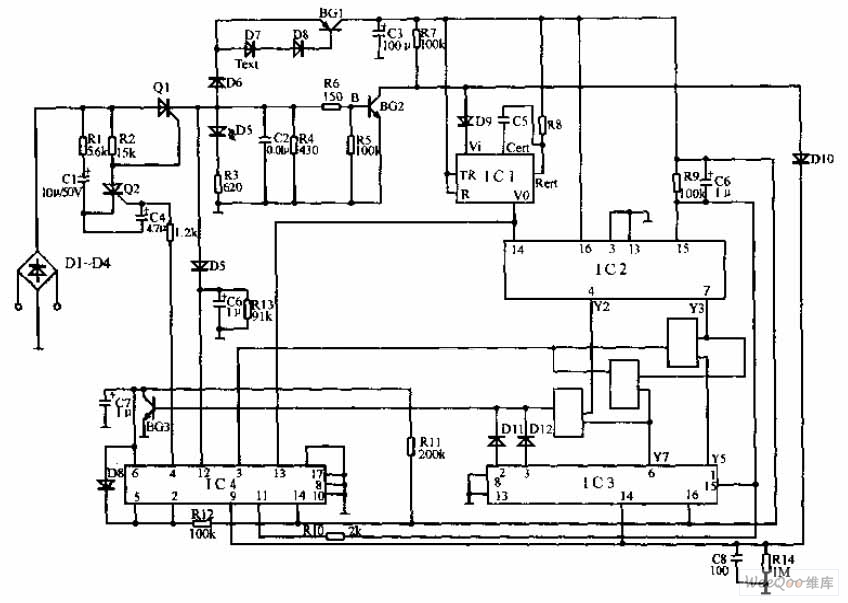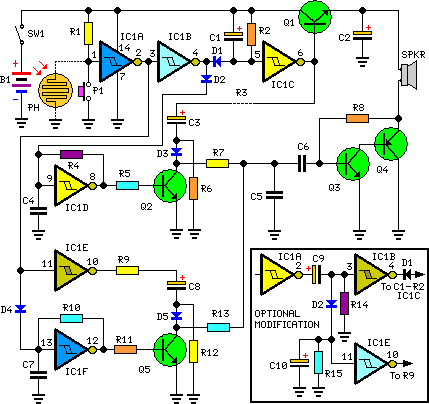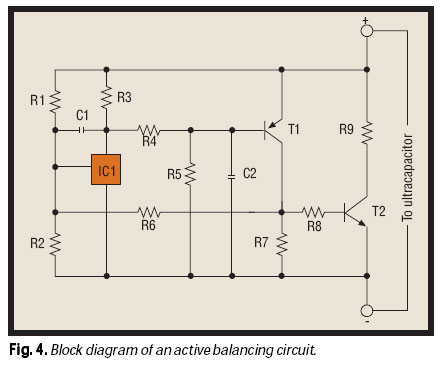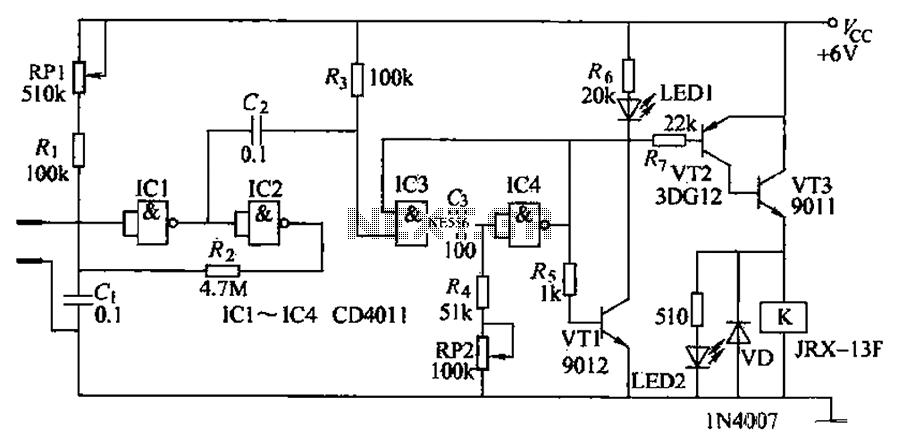
Pulse phone 160168 controller circuit diagram

The pulse telephone 160 168 controller circuit is depicted above. This controller can be installed either on the telephone or on the switchboard of the trunk line. It effectively prevents unauthorized dialing of numbers 160 and 168. Diodes D1 to D4 are 1N4004, while the other diodes utilize 1N4008. Transistors Q1 and Q2 are BT169D; BG1 is a 5401, and BG2 is a 9014. The resistors are 0.125W metal film resistors, and IC1 is a CC4098.
The pulse telephone controller circuit is designed to enhance security and control over specific telephone numbers. It can be integrated into various telephone systems, offering flexibility in installation. The circuit fundamentally relies on a series of diodes and transistors to manage and restrict dialing capabilities.
The diodes, particularly the 1N4004 and 1N4008, are utilized for their rectifying properties, ensuring that the circuit operates effectively by preventing reverse current that could damage sensitive components. The choice of the BT169D transistors for Q1 and Q2 indicates a reliance on thyristor technology, which is beneficial for handling higher power loads and providing reliable switching capabilities. The 5401 transistor (BG1) serves as a general-purpose power transistor, suitable for switching applications, while the 9014 (BG2) is a low-power transistor used for signal amplification.
The use of 0.125W metal film resistors provides stability and precision in the circuit's performance, minimizing noise and ensuring accurate operation. The CC4098 integrated circuit plays a crucial role in the control logic of the circuit, likely functioning as a dual operational amplifier or comparator, which aids in the detection and processing of pulse signals.
This configuration allows for the effective monitoring of dial pulses, ensuring that the system can discern between legitimate and unauthorized dialing attempts. By implementing this controller, telephone systems can maintain integrity and prevent misuse, making it an essential component in environments where security is a priority.Pulse telephone 160 168 controller circuit is shown as above, the controller can be installed on the phone or on the switchboard of the trunk. It can effectively prevent the others to freely dail 160, 168. D1 ~ D4 use 1N4004, the rest diode use 1N4008. Q1, Q2 use BT169D; BG1 uses 5401, BG2 uses 9014; Resistor uses 0.125W metal resistor; IC1 is CC4098. IC2,.. 🔗 External reference
The pulse telephone controller circuit is designed to enhance security and control over specific telephone numbers. It can be integrated into various telephone systems, offering flexibility in installation. The circuit fundamentally relies on a series of diodes and transistors to manage and restrict dialing capabilities.
The diodes, particularly the 1N4004 and 1N4008, are utilized for their rectifying properties, ensuring that the circuit operates effectively by preventing reverse current that could damage sensitive components. The choice of the BT169D transistors for Q1 and Q2 indicates a reliance on thyristor technology, which is beneficial for handling higher power loads and providing reliable switching capabilities. The 5401 transistor (BG1) serves as a general-purpose power transistor, suitable for switching applications, while the 9014 (BG2) is a low-power transistor used for signal amplification.
The use of 0.125W metal film resistors provides stability and precision in the circuit's performance, minimizing noise and ensuring accurate operation. The CC4098 integrated circuit plays a crucial role in the control logic of the circuit, likely functioning as a dual operational amplifier or comparator, which aids in the detection and processing of pulse signals.
This configuration allows for the effective monitoring of dial pulses, ensuring that the system can discern between legitimate and unauthorized dialing attempts. By implementing this controller, telephone systems can maintain integrity and prevent misuse, making it an essential component in environments where security is a priority.Pulse telephone 160 168 controller circuit is shown as above, the controller can be installed on the phone or on the switchboard of the trunk. It can effectively prevent the others to freely dail 160, 168. D1 ~ D4 use 1N4004, the rest diode use 1N4008. Q1, Q2 use BT169D; BG1 uses 5401, BG2 uses 9014; Resistor uses 0.125W metal resistor; IC1 is CC4098. IC2,.. 🔗 External reference





